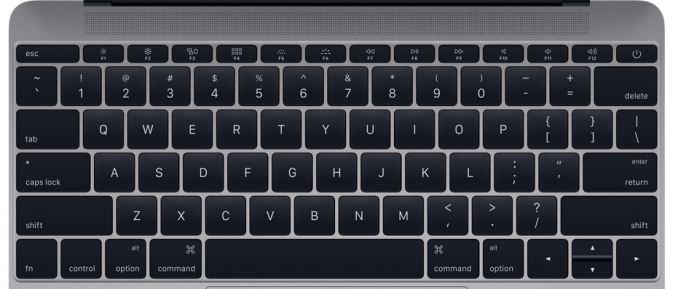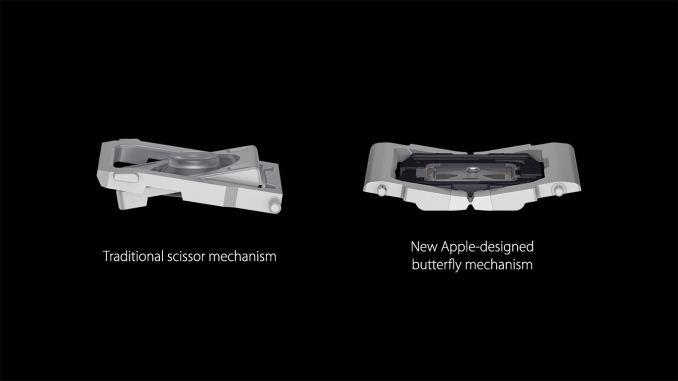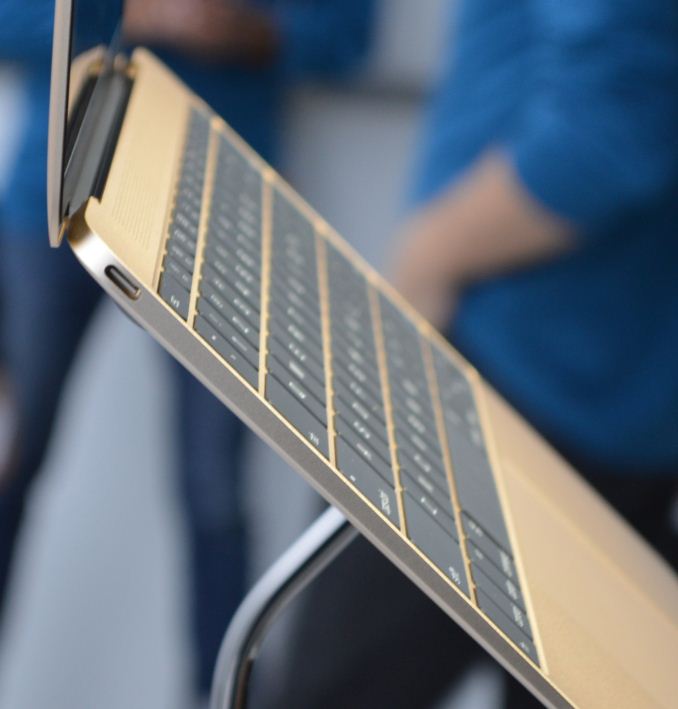The 2015 MacBook Review
by Ryan Smith on April 14, 2015 10:15 AM ESTGetting Thinner: New Keyboard, Keys, & Switches
One of the more interesting and not immediately obvious set of improvements to the MacBook come in the form of new internal mechanisms for the keyboard and trackpad. Though both look the same – and largely behave the same – as Apple’s existing products, under the hood they’ve been doing some work to improve these input devices. The driving factor of course is to further reduce the amount of Z-height these two devices take up, but there’s also a secondary focus on improving their functionality overall.
Starting with the keyboard, on the surface the MacBook implements a keyboard very similar to the now-traditional MacBook Air keyboard, incorporating a few smaller changes since their last design. Still a “full size” 78 key design that includes a top row of short function keys, Apple has made some changes to the keys themselves. Of note, the “inverted T” design of the arrow keys has been removed in favor of full size left and right arrow keys, giving the MacBook a somewhat odd arrangement where left/right are larger than up/down, rather than being identical in size as before. In Apple’s older design the space above left/right is empty space, so nothing is being sacrificed for this, but touch typists accustomed to the short arrow keys are going to have to do some adapting. Meanwhile at the other corner the escape key has been slightly elongated so that it’s wider than a normal key, and the other function keys have each been slightly narrowed to compensate.

Top: MacBook Keyboard. Bottom: MacBook Air Keyboard
Apple has also changed the overall size of the other keys, though even regular Mac users may have trouble picking up on this. The keys are now 17% larger, with Apple having slightly reduced the amount of space between each key to compensate. Meanwhile the keys are also have a deeper curve, which Apple tells us is 50% deeper. Truth be told, if not for the fact that Apple took the time to point this out in their reviewer’s guide I likely would not have picked up on either of these changes; the wider keys are noticeable once you know what to look for, but only just. Ultimately I don’t find the MacBook’s keyboard to be any different to type on as far as key size and feel goes (even with my large fingers), but your mileage may vary.

Backlit Keys: Minimal Edge Lighting
Meanwhile under the hood Apple has reworked the backlighting mechanism. The fiber optic lighting system that has been common in Apple’s designs until now has been replaced with a direct LED backlighting system, with each key having its own LED. Apple tells us that this was done for size reasons, as the direct backlighting system was smaller than the fiber optic lighting system. Not unexpectedly, this also changes how the overall backlighting system looks. The individual keys are as bright as ever – and Apple has gone so far to calibrate the LEDs to make sure they’re uniform – but with the LEDs now under the keys the amount of light around the edges of the keys has been greatly reduced. There is still some edge bleed, but now the lighting is much more focused on the symbols of the keys as opposed to lighting up the symbols and giving the keys a light border in the process.
Last but certainly not least however is the new key mechanism used underneath key, with like a number of other technologies is being first introduced on the MacBook. Apple has forgone the traditional scissor switch in favor of a newly designed mechanism they’re calling the butterfly switch, which in the slow-moving world of keyboards is the first significant change in quite some time.
The purpose of the butterfly switch is two-fold. The first of course is to reduce the size of the switch, allowing Apple to make the keyboard and resulting laptop thinner. Officially the butterfly switch is 40% thinner than Apple’s traditional scissor mechanism. That said, I’m not entirely convinced that Apple needed to switch mechanisms to reduce the keyboard thickness (though perhaps not getting 40% thinner), as we’ve seen other keyboards such as the Surface Pro 3’s type cover use some very thin scissor switches. Instead I suspect Apple’s change was focused on key stability as well.
Along with allowing for thinner keys, the other major improvement in the butterfly switch is key stability. By making the butterfly mechanism symmetrical Apple has done away with the scissor switch’s corner instability, which if pressed at a far corner would allow the scissor mechanism to actuate without actually triggering the switch. With the butterfly switch essentially composed of two identical halves that each prop up their respective corners, the instability has been eliminated as all four corners are similarly supported.
The end result, as Apple likes to pitch it, is that butterfly-backed keys are more stable and have the same feel to them no matter where on the key you press. And true to their word, in my experience this is exactly the case. The MacBook’s keys feel the same no matter where you press, and more importantly we haven’t encountered any failed keypresses in our formal or informal keyboard testing. Having used a number of scissor keyboards over the years, including a couple that suffered from non-registering corner keypresses, this is a welcome change as it’s seemingly impossible to have a key fail to register. That said the quality of scissor mechanisms definitely varies on a vendor-by-vendor basis, and with Apple’s scissor mechanism already performing well, I’m not sure if this is really all that big of a step up from other Apple designs. On the other hand what I’ve also found is that the instability problems of scissor keyboards seem to get worse as they get thinner, so it’s quite likely that Apple needed to make this change as they wouldn’t have been able to maintain their high keyboard quality with an even thinner scissor switch keyboard.
In any case, the other big change to keyboard feel is that due to the thinner switches, the total amount of key travel is significantly reduced. While the MBA and other Ultrabooks already had fairly low key travel, the MacBook’s keyboard reduces it yet again, and coupled with the changes in switches it makes the MacBook keyboard feel very different at times, and this is a difference that can take some getting used to at first. As thin as the switches are they’re closer to buttons than traveling keys – think iOS device home button – so typists accustomed to more travel and spring in their keys will immediately pick up on the difference, and I would wager take a temporary hit in words per minute (WPM) until they’ve fully adapted. After having used the MacBook for a week I can already type on it as well as I can my MacBook Pro, so it’s a relatively short adjustment period, but it’s there.
For a device of its size, overall I’d consider the MacBook’s keyboard to be an improvement over similar designs. That said, while I wouldn’t be surprised to see the backlighting improvements and key size changes eventually brought over to other MacBook designs, I don’t imagine we’ll be seeing the butterfly switch used on other, larger designs where Apple doesn’t need to be so conservative on space. As well as it works here, Apple doesn’t have the same need to deviate from the greater travel of scissor switches in their larger laptops.













354 Comments
View All Comments
darkich - Wednesday, April 15, 2015 - link
Oh Anandtech, it is blatantly obvious that you do everything you can to twist reality in favor of your sponsor (Intel).So MacBook has a twice better GPU than iPad Air 2?
Why didn't you used a *graphics* category to explain that fact?
Why didn't you ran Manhattan or T Rex and showed the respective scores?
iLovefloss - Wednesday, April 15, 2015 - link
They linked to a more comprehensive Core M review in the article. If you actually read the damn thing rather than trying to accuse people of being sellouts, then you maybe you'd caught that.Shit, the only thing more annoying than a social media (anti-)SJ conversation is tech websites review comments. Everybody is a sellout.
narcaz - Wednesday, April 15, 2015 - link
I am sorry, but i think this one of the of the more mediocre reviews from Anandtech:"Compared to the 128GB SSD and 4GB of RAM in the base MacBook Airs, this is the first ultra-portable Mac in a while where I can say even the base model feels properly equipped. At the very least users shouldn’t be struggling with RAM or SSD capacity for some time. Meanwhile given the fact that the equivalent upgrade of an 11” MacBook air would be $300 – bringing the total price to $1199 – this means that while the MacBook is still more expensive than a MacBook Air, the difference isn’t nearly as wide as it would first seem."
Copy paste from Apple's marketing? The difference is as wide as it would first seem when you look at the trade-off. Compared to the MBA you get better portability and a retina screen. But you loose connectivity, battery life, hd camera, magsafe, cpu/gpu performance. And according to your defined target audience (second device buyers) buying these upgrades doesn't make much sense. It is ok that the 12'' MB is expensive, but don't try to argue around this fact.
"As far as desktop performance goes, we haven’t found any major problems for the MacBook’s Intel HD Graphics 5300 GPU. Even with Core M’s power limits it doesn’t show any issues holding 60fps at the default virtual resolution of 1280 x 800, though I would not suggest going any higher unless it’s necessary."
I had the impression that higher resolutions don't work very well on the 12'' MB models in the Apple store. It felt like the first 13'' rMBP: more screen space, but a bit laggy. The performance of the HD 4000 wasn't good enough and took another hit with Yosemite (especially when connected to a second display). I am not willing to invest in a MB, which isn't future proof for at least 2-3 years. The same is true for the potential lack of 4K/60hz. I hoped for more depth in this area.
The review could have been more critical about the 1 USB C Port. If it breaks you can't even charge your machine anymore and out of warranty services are extremely expensive. But i think the comments discussed this point to death. Thanks for the extra remarks about the sustained performance in the comments and please put this in the review and maybe do more tests.
wave84 - Wednesday, April 15, 2015 - link
I don't really think the Macbook is expensive. This is actually useable as a main computer for a lot of users (journalists, web designers, web programmers, etc). It will do just fine, as long as you have 8GB RAM and 256 for storage, which you get.You lose some stuff indeed, but for 100 bucks you get retina screen, extreme portability, and most important of all, it's fanless and completely silent. This is a huge quality of life improvement which no review will take into account.
Also, i do not believe the port to be an issue. Either you are docked, so you have plenty of ports (and you only unplug one cable), either you are mobile, when one port is enough for 99% of use cases.
I am very close to buying it. Still waiting for some upgraded CPU numbers.
narcaz - Wednesday, April 15, 2015 - link
I am looking for a second device besides my 15'' rMBP. The iPad doesn't cut it anymore. But 1279$ + 79$ (needed for occasional presentation) is expensive compared to the 11'' MBA 899$+29$. Impossible to sugarcoat it. It looks like Apple's upselling strategy got you on the hook. You can rationalize this purchase as much as you want, but i don't want to pay for upgrades, which i don't need. If you value portability and retina screen fine, enjoy it, but this doesn't make it a very good deal.Even in the Apple ecosystem the single port is problematic. Airplay Screen Mirroring suffers from lags, iCloud Photo Library is cumbersome and there is no backup solution while being on the road. Cables aren't dead. I think the next version will have second port.
telsin - Wednesday, April 15, 2015 - link
I'm curious to see if a newer hardware revision of the Apple TV that they're likely to announce at WWDC resolves some of the airplay lag. That thing is still using an A5 processor, whereas the latest iphones are up to A8 (huge difference in CPU/GPU performance). I too found airplay rather obnoxious when I tried it. In OSX, you can have it treat an airplay target as a second monitor, but it really kind of sucks unless you're just putting something there to read as a static document.bogda - Wednesday, April 15, 2015 - link
Now, make MacBook Air with the same quality screen, smaller bezel (like on this MacBook) and keyboard that stretches from edge to edge (like on this MacBook) and I might actually switch from PC to Mac.Mushin - Wednesday, April 15, 2015 - link
As for the SSD which is only connected through PCIe 2.0 that is a limitation of Core M see:http://ark.intel.com/products/84666/Intel-Core-M-5...
cknobman - Wednesday, April 15, 2015 - link
All I can say is ehh.Sure its built nice and a super small form factor
BUT
Price is high, performance is just OK, and battery life is frankly underwhelming. Sure the battery life is not terrible but given the hype over the Core M I was expecting better battery life.
Still no touch screen and it is still confined to the limitations of a laptop.
The benefit of small underpowered devices like this should lie in their ability to serve multiple purposes easily and change form factors.
If I still have to use it like a laptop (IE: open it up, type on a keyboard) and pay such a high price then I may as well go get a laptop with more power and better battery life.
For this price I'd still rather have something like a Surface Pro 3. With its ability to serve multiple purposes I can use it like a tablet or a laptop, get better battery life, and get a touch screen. All while paying less.
nerd1 - Wednesday, April 15, 2015 - link
Sp3 is lighter, thinner, more powerful, has more ports, has more input methods and even cheaper.